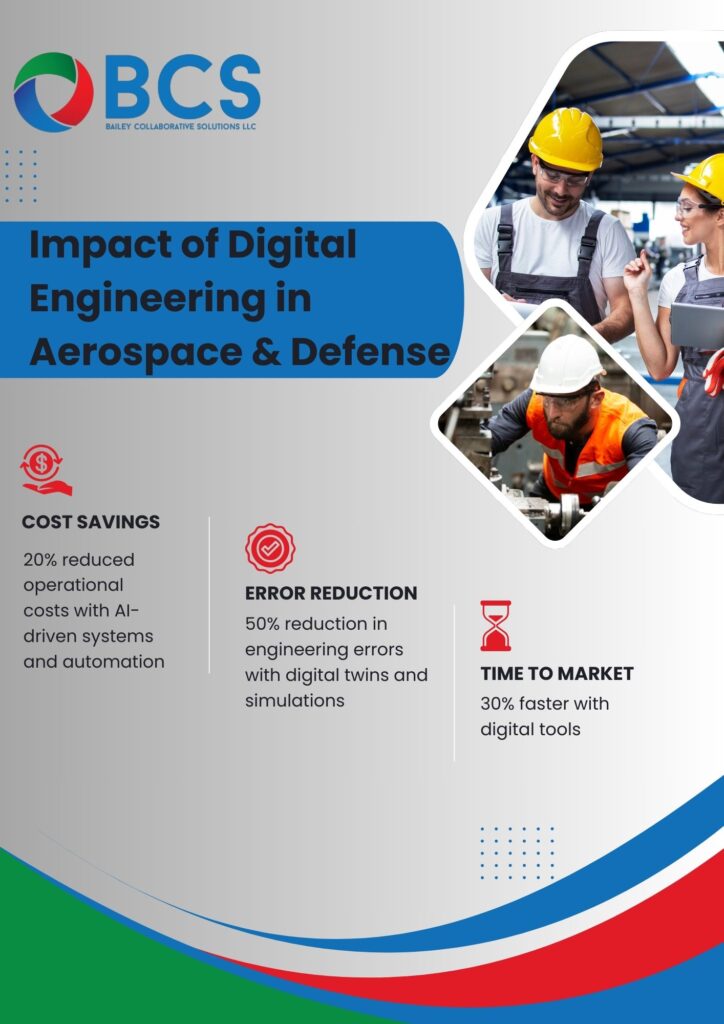Digital engineering is no longer a new development, however, keeping up with the current trends of digital engineering tools necessary for maximal execution can be cumbersome.
Every major sector is currently working on ways to implement digital engineering in its defense and space sectors. In 2019, the DoD released a newsletter declaring its efforts toward this implementation. This further goes to show the level of importance of this niche.
At Bailey Collaborative Solutions (BCS), we understand that staying ahead of the curve in terms of digital engineering tools will prime you and your company for productivity and increase the trust of your customers or clients. That’s why we bring to you this list of digital engineering tools necessary to add to your catalog as an engineer pushing for future advancements.
The Growing Need for Digital Engineering in Defense & Space

The shift toward modernization in defense and aerospace is already well underway. Digital engineering blends traditional engineering practices and advanced technology-driven solutions, enabling industries to preserve established methodologies while embracing transformative change.
As of 2024, the Department of Defense has committed over $10 billion to support the integration of advanced digital engineering tools and solutions, highlighting the importance of staying ahead in defense technology development
More specifically, technological advancements in digital engineering have permeated every facet of the defense and aerospace sectors, delivering a range of immediate benefits that highlight its essential role. Some of the key advantages include:
Accelerated System Development
Digital engineering tools, such as Model-Based Systems Engineering (MBSE), dramatically speed up the development and iteration of military and aerospace systems.
By enabling digital prototypes and simulations, MBSE accelerates the entire lifecycle—from concept to design and beyond. In addition, tools like 3D modeling simplify the creation of physical models, reducing the time and resources traditionally spent on manual processes.
Enhanced Error Reduction
Digital engineering introduces significant improvements in error handling. Digital twins, combined with AI-powered simulations, offer predictive maintenance allowing engineers to test various scenarios and anticipate potential failures before they occur.
This capability is particularly critical in the aerospace sector, where precision and reliability are paramount for both design and operational success.
Increased Automation
One of the key advancements brought by digital engineering is automation, particularly in repetitive or minor tasks.
Automation of routine processes such as data collection and initial system checks allows engineers to focus on critical tasks like testing and system optimization. This increased efficiency allows for quicker iteration cycles and more robust final products.
Improved Data Security
Cybersecurity is an integral part of the digital engineering framework, ensuring the safety of sensitive data across all stages of development.
Unlike traditional systems that rely on reactive measures, digital engineering software tools offer proactive security solutions, safeguarding all data—particularly in high-stakes defense and aerospace applications—before deployment or launch.
Essential Digital Engineering Tools for 2025
As industries continue to embrace digital transformation, the adoption of advanced engineering tools is becoming crucial for maintaining competitiveness and operational efficiency.
These digital engineering tools help to manage digital platform engineering and cover various aspects of data management, data storage, testing, production, and interdisciplinary collaboration. The following digital engineering tools are expected to play a pivotal role in 2025, driving innovation and enhancing capabilities within these sectors.
1. Model-Based Systems Engineering (MBSE)
Model-Based Systems Engineering (MBSE) tools help engineers leverage digital models to provide a comprehensive framework for system design, analysis, and validation.
MBSEs are more like methodologies involved in digital product engineering for creating systems and prototypes from ideas. They can be implemented in the design and facilitation of structures such as military aircraft and space exploration vehicles.
Some recommended MBSE tools include;
2. Digital Twin Technologies
A digital engineering tool that will gain more popularity in 2025 will be the digital twin. These tools lead the way in predictive maintenance and assist engineers with virtual representations of what production will be like.
According to recent research, Digital twin technologies are projected to reduce the time for testing and validating simulation-driven product design by up to 30% in defense systems development. With this technology, you are able to observe performance, failures, and system stability. It can be used to simulate things like defense systems in several scenarios
Some recommended Digital Twin tools include;
3. AI-Driven Data Analytic Tools
Artificial Intelligence (AI)’s place in the aerospace and defense scene has begun to take shape. More advancements are coming in, but as of 2025, the most common use-case of AI in the industry is as digital engineering software tools for data analysis, as well as contribution to automation systems. In the future, it is obvious that AI will have a hand in remote systems such as auto-driving and auto-pilot systems. The most advanced AI tools do not have just singular uses.
Some recommended AI analytic tools include;
4. Cloud-Based Digital Engineering Workspaces
Teamwork and multidisciplinary approaches are not left behind in the new world. Cloud-based platforms are available to ensure team collaboration and safe exchange of information. Because of the technological touch, these tools make it easier to merge ideas and actualize system models from a combination of contributions.
These tools have integrated Product Lifecycle Management (PLM) with Computer Aided Design (CAD) to ensure seamless collaboration and development progress.
Some recommended Cloud-based platforms include;
5. Cybersecurity Technologies
With advanced solutions come advanced threats. Threat to security is one of the most important to cut off before they develop and having a strong cybersecurity setup will help secure this. There is no question that protecting the data of our defense and aerospace advancements will help with staying ahead at all times.
Some recommended Cybersecurity tools include;
- IBM QRadar
- Synopsys Coverity
Securing Expert Digital Engineering Services

The Defense and Aerospace sectors will benefit largely from the technological benefits of these digital engineering tools. From easing automation to model replication, data safety, and promoting collaboration, utilizing these tools is the best way to go for all engineers involved. BCS offers all engineering and technical services necessary for every engineer to thrive. And it mostly begins with using the right tools.




